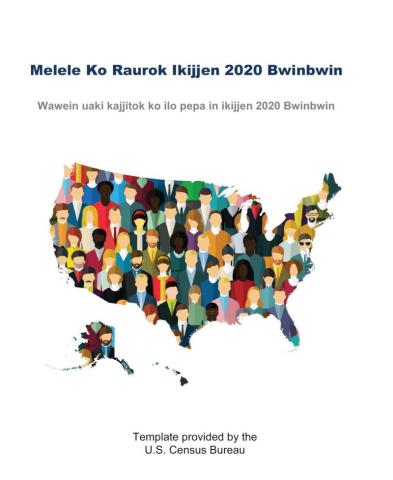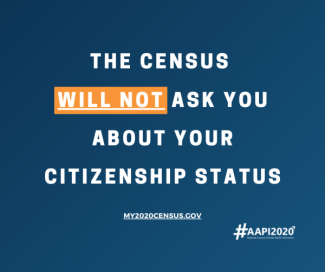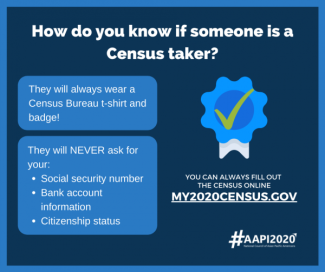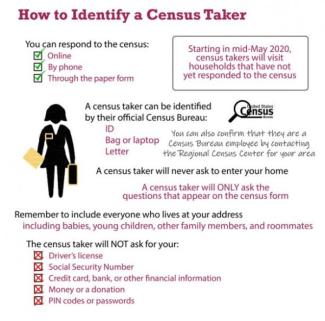Every ten years, the U.S. Census Bureau undergoes a count of the population of the country and five U.S. territories. The Census count helps inform everything from representation in the U.S. House of Representatives, to local funding for infrastructure projects, to funding allocations for programs like CHIP, school lunch, and Medicare/Medicaid.
It is vitally important that every person is counted in the U.S. Census, but a 2019 report from the Census Bureau shows that AAPIs are the demographic least likely to fill out the Census, and the most concerned with their information being used against, and face additional barriers like language access.
To assist with full count efforts throughout Washington, CAPAA has compiled helpful resources for community organizations and individuals, including Needs Assessments that CAPAA conducted with KAYA Strategik in Clark County, Thurston County, and Whitman County.
-
2020 Census and COVID-19
-
In light of COVID-19, the U.S. Census Bureau is adjusting their plans as necessary. You can read find more information and full statements on their page, including information on general changes, field operations, the temporary suspension of in-person interviews, and modifications to ensure college students are fully counted. During this time, individuals are encouraged to fill out the Census, and can do so safely online, by phone, or by mail.
Regularly check the Census Bureau’s website for updates on 2020 Census Operational Adjustments Due to COVID-19 for the latest information on schedule changes.
Census Counts, a collaboration Census campaign involving more than 40 national organizations and dozens of community partners, has a page of COVID-19 Resources as it relates to the Census, including talking points.
Count Us In 2020, from Asian Americans Advancing Justice, is tracking updates on the 2020 Census and COVID-19, and have in-language guidance documents:
-
General Information & Toolkits
-
- Southeast Asian Diaspora (SEAD) Project “SEA Us Now” 2020 Census Toolkit
- Asian American & Pacific Islander 2020 Complete Count Collective
- Count Us In: 2020 Census Get Out the Count Community Engagement and Communications Toolkit
- Census Bureau translated webpages
- Amharic / አማርኛ
- Bengali / বাংলা
- Chinese (Simplified) / 中文(简体)
- Chinese (Traditional) /中文(繁體)
- Farsi / فارسی
- Gujarati / ગુજરાતી
- Hindi / हिन्दी
- Hmong / Hmoob
- Ilocano / Ilokano
- Indonesian / Bahasa Indonesia
- Japanese / 日本語
- Khmer / ខ្មែ រ
- Korean / 한국어
- Lao / ພາສາລາວ
- Malayalam / മലയാളം
- Marathi / मराठी
- Nepali / नेपाली
- Punjabi / ਪੰਜਾਬੀ
- Sinhala / සිංහල
- Tagalog / Tagalog
- Tamil / தமிழ்
- Telugu / తెలుగు
- Thai / ไทย
- Tigrinya /ትግርኛ
- Urdu / اردو
- Vietnamese / Tiếng Việt
- Count Us In: Translated GOTC Materials
- 中文 – Chinese Simplified
- 中文 – Chinese Traditional
- ဗမာ – Burmese
- ગુજરાતી – Gujarati
- हिंदी – Hindi
- hmoob – Hmong
- Iu-mienh – lu Mien
- 日本人 – Japanese
- 한국어 – Korean
- ខ្មែរ Khmer | ລາວ – Lao
- मराठी – Marathi
- नेपाली – Nepali
- ਪੰਜਾਬੀ – Punjabi
- தமிழ் – Tamil
- Tagalog
- ไทย – Thai
- Tiếng Việt – Vietnamese
- اردو – Urdu|
- Español – Spanish
- عربى – Arabic
-
Social Media Resources
-
- Census Bureau YouTube Page
- SEARAC Social Media Shareables
- National Council on Asian Pacific Americans (NCAPA) March Census Toolkit (general + NHPI specific)
- NCAPA Census Graphics: Part 1, Part 2
- APIAVote Census Explainer Videos
- Bengali/বাংলা
- Burmese / မြန်မာဘာသာ
- English
- Bahasa Malaysia
- Chamorro
- Chinese Simplified / 中文(简体)
- Chinese Traditional / 中文(繁體)
- Chuukese
- Gujarati / ગુજરાતીv
- Hindi / हिन्दी
- Hmong / Hmoob
- Japanese / 日本語
- Khmer / ខ្មែ រ
- Karen
- Korean / 한국어
- Lao / ພາສາລາວ
- Marshallese
- Nepali / नेपाली
- Palauan
- Punjabi / ਪੰਜਾਬੀ
- Samoan
- Tagalog
- Tamil / தமிழ்
- Telugu / తెలుగు
- Tongan
- Thai / ไทย
- Urdu /اردو
- Tiếng Việt
- Vakavit
-
Languages Guides
-
The U.S. Census Bureau provides many different Census Language Guides available, which point to each Census question and offers a translation. Keep in mind that language guides are created to pair with the paper version of the questionnaire. Although the online portal includes the same questions as the paper form, it looks different, and asks the Census Code you received on your mail invitation to participate in the Census. Language Guides available include, but are not limited to:
- English
- Chinese (simplified) / 中文(简体)
- Chinese (traditional) / 中文(繁體)
- Vietnamese / Tiếng Việt
- Korean / 한국어
- Tagalog / Wikang Tagalog
- Japanese / 日本語
- Amharic / አማርኛ
- Bengali / বাংলা
- Burmese / မြန်မာစာ
- Gujarati / ગુજરાતી
- Hindi / हिन्दी
- Hmong / Hmoob
- Ilocano / Ilokano
- Indonesian / Bahasa Indonesia
- Khmer / ភាសាខ្មែរ
- Lao / ພາສາລາວ
- Malayalam / മലയാളം
- Marathi / मराठी
- Nepali / नेपाली
- Punjabi / ਪੰਜਾਬੀ
- Sinhala / සිංහල
- Tamil / தமிழ்
- Telugu / తెలుగు
- Thai / ภาษาไทย
- Tigrinya / ትግርኛ
- Urdu / اردو
Count Us In 2020, in partnership with Empowering Pacific Islander Communities (EPIC), has also provided the following NHPI Language Guides:
Additionally, thanks to the efforts of the Spokane County Census Committee and other community members, we now have a translated language guide in Marshallese!

-
Protect Yourself: Frauds & Scams
-
With the heightened fear due to the possibility of a citizenship question, many people–particularly in the AAPI community–worry that their information may be used against them, or are otherwise unsure how to identify a Census taker.
Read the U.S. Census Bureau’s page on the topic: Avoiding Frauds and Scams,
Read the Federal Trade Commission’s page on the topic: 2020 Census: Fact v Fiction
The AARP also has translated Frauds & Scams Tip Sheets:
- Census Fraud and Scams Tip Sheet (English)
- Fraud and Scams Tip Sheet (Chinese – Traditional)
- Fraud and Scams Tip Sheet (Korean)
- Fraud and Scams Tip Sheet (Vietnamese)
- Fraud and Scams Tip Sheet (Spanish)



-
Response Rates Map
-
Census Hard to Count (HTC) Map 2020

